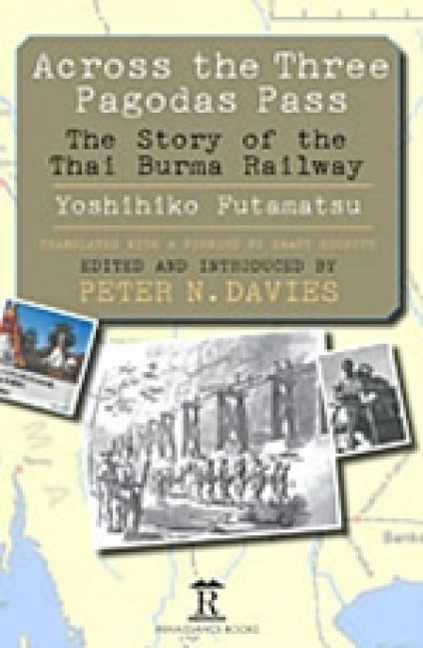Book contents
- Frontmatter
- Dedication
- Contents
- Acknowledgements
- Foreword
- Introduction
- Across the Three Pagodas Pass
- Translator’s Acknowledgements
- Preface
- Chapter 1 Departure for the Front
- Chapter 2 In Indo-China
- Chapter 3 Opening of Hostilities
- Chapter 4 The River Krian
- Chapter 5 The Malayan Campaign
- Chapter 6 The Fall of Singapore
- Chapter 7 Surrender
- Chapter 8 Shōnan: Light of the South
- Chapter 9 The Thai-Burma Railway
- Chapter 10 Preparing Construction
- Chapter 11 Banpong
- Chapter 12 Prisoners-of-War
- Chapter 13 Constructing the Railway
- Chapter 14 Thailand
- Chapter 15 The River Kwae Noi
- Chapter 16 The Mae Khlaung Bridge
- Chapter 17 Kanchanaburi
- Chapter 18 The Jungle
- Chapter 19 From Bangkok to Singapore
- Chapter 20 Rush Construction
- Chapter 21 The Base at Wanyai
- Chapter 22 The Labour Force
- Chapter 23 Survey Unit
- Chapter 24 Test Run
- Chapter 25 Bridge-Building and Shifting Earth
- Chapter 26 The Rainy Season: The Monsoon
- Chapter 27 Kinsaiyok
- Chapter 28 Diseases and Epidemics
- Chapter 29 Cattle Drive
- Chapter 30 Living in the Jungle
- Chapter 31 Soon to the Three Pagodas Pass
- Chapter 32 Towards the Setting Sun
- Chapter 33 Opening to Traffic
- Chapter 34 The Bombing
- Chapter 35 End of the War
- Chapter 36 Internment
- Chapter 37 Repatriation
- Footnote
- Postscript
- End Notes
- Glossary
- Bibliography
- Index
Chapter 32 - Towards the Setting Sun
Published online by Cambridge University Press: 13 May 2022
- Frontmatter
- Dedication
- Contents
- Acknowledgements
- Foreword
- Introduction
- Across the Three Pagodas Pass
- Translator’s Acknowledgements
- Preface
- Chapter 1 Departure for the Front
- Chapter 2 In Indo-China
- Chapter 3 Opening of Hostilities
- Chapter 4 The River Krian
- Chapter 5 The Malayan Campaign
- Chapter 6 The Fall of Singapore
- Chapter 7 Surrender
- Chapter 8 Shōnan: Light of the South
- Chapter 9 The Thai-Burma Railway
- Chapter 10 Preparing Construction
- Chapter 11 Banpong
- Chapter 12 Prisoners-of-War
- Chapter 13 Constructing the Railway
- Chapter 14 Thailand
- Chapter 15 The River Kwae Noi
- Chapter 16 The Mae Khlaung Bridge
- Chapter 17 Kanchanaburi
- Chapter 18 The Jungle
- Chapter 19 From Bangkok to Singapore
- Chapter 20 Rush Construction
- Chapter 21 The Base at Wanyai
- Chapter 22 The Labour Force
- Chapter 23 Survey Unit
- Chapter 24 Test Run
- Chapter 25 Bridge-Building and Shifting Earth
- Chapter 26 The Rainy Season: The Monsoon
- Chapter 27 Kinsaiyok
- Chapter 28 Diseases and Epidemics
- Chapter 29 Cattle Drive
- Chapter 30 Living in the Jungle
- Chapter 31 Soon to the Three Pagodas Pass
- Chapter 32 Towards the Setting Sun
- Chapter 33 Opening to Traffic
- Chapter 34 The Bombing
- Chapter 35 End of the War
- Chapter 36 Internment
- Chapter 37 Repatriation
- Footnote
- Postscript
- End Notes
- Glossary
- Bibliography
- Index
Summary
In July, when the rainy season was due to start, in the construction work at Songkurai no distinction was made between day and night on rush-construction work. For the railway engineers, prisoners-ofwar and coolies alike, shouts of ‘Speedo!’ chased everybody up and the work went on without a break.
It was around that time when an incident occurred in which a British prisoner-of-war in the camp at Songkurai broke out and escaped. He was Lieutenant James Bradley, RE, who was blessed with good luck and after the war was repatriated. In 1982 he wrote an account of his escape, published under the title Towards the Setting Sun. I was given a copy by the author and was able to get his permission to quote parts of it, an account of the Thai-Burma Railway as seen by a prisoner-of-war.
Lieutenant Bradley hailed from Cheshire in England. On 13 January 1942 in the transport Duchess of Atholl (Futamatsu wrote Richmond in error), in company with part of the British 18 Division, he had entered Keppel Harbour, the port of Singapore. England had already declared war on Japan and they arrived as reinforcements for the defending army in Malaya. Bradley was an officer in 18 Division's 53 Brigade Group's engineering company: they moved into a frontline position at Ayer Hitam in Johore, but almost at once the British defence gave way to the Japanese offensive and by the end of January, inevitably, they had withdrawn into Singapore Island. On 15 February the commander of the defending army, Lt-General A.E. Percival, as the resources of war were dwindling and sources of water supply were drying up, ordered his total forces to stop fighting, and surrendered to the Japanese Army.
Barely a month after Lieutenant Bradley had landed in Singapore the surrender took place. He became a captive, and ended up by being imprisoned in Changi prisoner-of-war camp. Since the Spring of 1942 several tens of thousands of prisoners-of-war were accommodated at Changi, and around that time there was set up a labour force for the Thai-Burma Railway construction which was being started, and prisoners were moved in successive batches to the Thai-Burma area.
- Type
- Chapter
- Information
- Across the Three Pagodas PassThe Story of the Thai-Burma Railway, pp. 157 - 173Publisher: Amsterdam University PressPrint publication year: 2013



